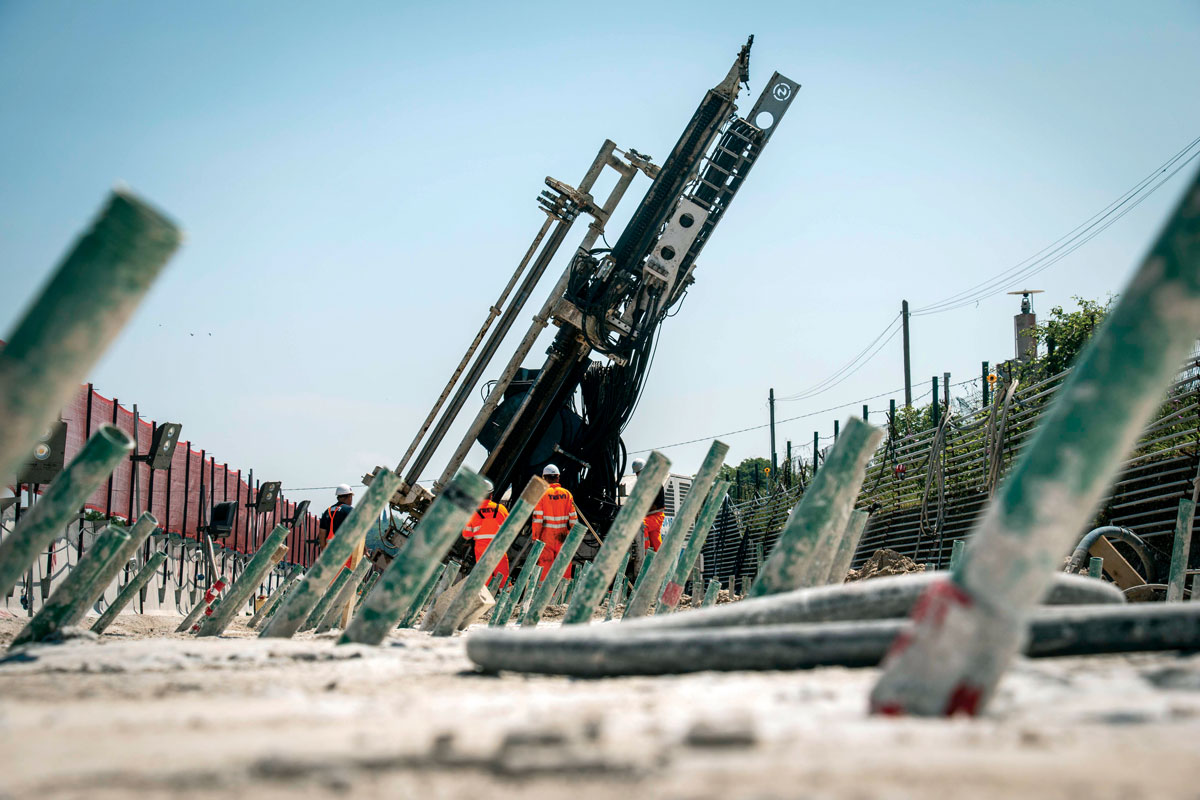
Photos: Courtesy of Trevi Group
The new Brescia-Verona High-Speed/High-Capacity railway line is a key project of the Milan-Verona railway link. It is part of the Turin-Trieste line which, in turn, is part of the wider system connecting Spain to the Ukrainian border.
The implementation of the project has been entrusted to the CEPAV DUE consortium, and commissioned by Rete Ferroviaria Italiana, while the high supervision and construction works supervision have been entrusted to ITALFERR. The demanding consolidation and foundation works have been entrusted to Trevi, a leading company in the execution of special foundation works.

The new Brescia East-Verona railway line is about 48-kilometres-long, mostly running along the A4 Milan-Venice freeway and crossing two regions and 11 municipalities.
The most complex and articulated project of the entire work is undoubtedly the Lonato Tunnel, entrusted to SELI OVERSEAS. It will be 7.9-km-long and will pass under the A4.
The initial section of the railway line interferes with the A4 freeway and significant buildings, located in the industrial area of the Lake Garda city.
Due to the small amount of overburden along the undercrossing of the A4 freeway and the buildings, the decision was made to carry out consolidation prior to mechanized excavation to minimize subsidence phenomena.
The purpose of the consolidation was to improve the physical-mechanical characteristics of the soil behind the excavation section for a thickness of about three metres.
Thanks to the collaboration between Trevi, SELI, CEPAV DUE and all involved parties, the consolidations and the inevitable technological and design implementations that are necessary for a project as articulated and complex as the Lonato Tunnel, are taking place according to the estimated schedule.


The purpose of Trevi’s work
The purpose of Trevi’s work is to pre-consolidate the soils surrounding the new Lonato Tunnel to allow the passage of the tunnel boring machine without causing any subsidence.
The initial design called for the sections to be consolidated to be treated with three different types of drilling, all starting from ground level:
- Sub-vertical drilling.
- Sub-horizontal drilling (remotely controlled by the HDD technology), with direction perpendicular to the tunnel axis.
- Sub-horizontal drilling consisting of a radius of curvature, also remotely controlled, with direction longitudinal to the axis of the tunnel.
The poor capacity of the soil to be permeated by the mixtures hypothesized by the project and the complex drilling geometry led the team to seek new design solutions.
Thanks to tests carried out at the onsite test field, the team was able to reshape the project mesh and develop mixtures more suitable for the soil.
In particular, four fundamental observations emerged from the test field:
- The adoption of a combination of cement and silicate-based chemical mixtures.
- The use of cement mixtures with low cement content to obtain better rheological features.
- The adaptation of the project mesh by increasing the number of valves per linear metre.
- The selection of sub-vertical drilling operations, carried out mainly at the head of the tunnel and no longer at floor level.

The purpose of the consolidation was to improve the physical-mechanical characteristics of the soil behind the excavation section for a thickness of about three metres.
New approach
To apply this new approach, the team was asked to drill from above, carrying out sub-vertical drilling entirely occupying the emergency lane in both directions without interrupting the A4 freeway traffic.
This work made it possible to refine and shorten working times, improving consolidation work between the tunnel and the freeway.
When the work is completed, 89,475 linear metres of drilling and grouting will have been carried out, using about 10 million litres of mixture.
Trevi is completing the intervention phase on A4, and the first results of the post-treatment tests show a clear improvement in the mechanical characteristics of the consolidated soils. Obviously, the continuation of the intervention will be subject to further post-treatment tests, which will be useful to evaluate the effectiveness of the grouting treatments. ![]()
-
CZM Foundation Equipment introduces CZM Capital Financing options for customers
April 25, 2024 -
Student Engagement Committee
April 25, 2024 -
DFI announces two new committees
April 25, 2024 -
Keller’s John Wolosick and Allen Sehn receive awards at the 2024 Geo-Institute’s Geo-Congress
April 25, 2024 -
Rod Kern appointed as vice president of Equipment Corporation of America
April 25, 2024